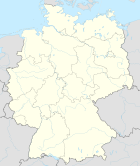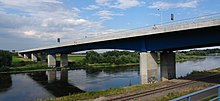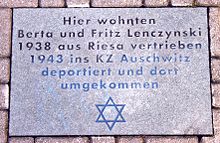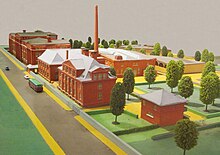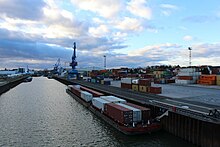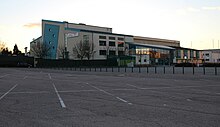Riesa
| coat of arms | Germany map | |
|---|---|---|

|
Coordinates: 51 ° 18 ' N , 13 ° 18' E |
|
| Basic data | ||
| State : | Saxony | |
| County : | Meissen | |
| Height : | 109 m above sea level NHN | |
| Area : | 58.91 km 2 | |
| Residents: | 29,754 (Dec. 31, 2019) | |
| Population density : | 505 inhabitants per km 2 | |
| Postcodes : | 01587, 01589, 01591 | |
| Area code : | 03525 | |
| License plate : | MEI, GRH, RG, RIE | |
| Community key : | 14 6 27 230 | |
| City structure: | 10 districts | |
City administration address : |
Rathausplatz 1 01589 Riesa |
|
| Website : | ||
| Lord Mayor : | Marco Müller ( CDU ) | |
| Location of the city of Riesa in the district of Meißen | ||
Riesa is a medium-sized town in the Saxon district of Meißen . It lies on an area of 58.91 square kilometers on the left side of the Elbe . The city was best known for its steel industry and as a sports city.
Riesa has had the status of a major district town in the Free State of Saxony since 1994 .
geography
Geographical location
Riesa is located on an Elbe bend and at the confluence of the Jahna and Döllnitz rivers , with the port following the end of the Döllnitz river course. The road courses are characterized by the Pausitzer Delle and the Heideberg . Riesa is located north of the Lommatzscher care .
Neighboring communities
Neighboring communities are Hirschstein , Nünchritz , Stauchitz , Zeithain and the city of Strehla in the district of Meißen and Liebschützberg in the district of northern Saxony .
City structure
Riesa has ten districts:
The Riesa district includes the city center and the districts of Göhlis , Gröba (with Gutsweiler Oberreußen ), Mergendorf , Merzdorf , Pausitz , Poppitz , Schwarzroda and Weida .
history
Say of the Riesa giant as the origin of the name
The legend was first recorded in 1785 by the Boritz pastor Johann Friedrich Ursinus. Once a giant came to the bank of the Elbe on his wandering. Before crossing the river, he stopped for a moment. He felt a pressure in his boots that came from the grains of sand and small stones that had accumulated over the long journey. He sat on the bank, groaned, pulled off his boots, and turned them over. This created a large hill on which Riesa's first houses were built. This is how the people of Riesa explain the name of their city.
Based on this story, the giant is one of Riesa's names. The giant crowns a variant of the city's coat of arms and is considered the city's mascot. Since 2004, the master brewer Gunter Spies from HammerBräu in Riesenhügel has officially embodied the Riesa city mascot. The Riesa giant is one of Saxony's most popular city mascots. For a number of years a huge festival was celebrated on the last weekend in August . The Riesaer Riese award is given annually in the city to citizens to be honored in the categories of economy, culture, sport, volunteer work and life's work. For the citizens' festival of 20 years of German unity in Dresden, he represented the entire district. In April 2014 he received the RIESAER GIANT in the honorary office category for 2013.
Historical origin of the name
In fact, Riesa is derived from Riez owe . This name, latinized as Reszoa , appears for the first time in a document from Pope Calixt II from October 1119, when Dietrich I , Bishop of Naumburg , consecrated the oldest monastery of the Mark Meissen . He used the name of the small Slavic settlement in the immediate vicinity of the monastery in the area where the Jahna flows into the Elbe. Risowe means something like terrain cut, so that the name of the city can be freely translated as "place at the river mouth" or "place on the river". The place name Riesa is first recorded in 1451.
Timetable
In the time of the Roman emperors and the migration of peoples , a nameless Elbe-Germanic small tribe of the Hermunduren is proven in the area around Riesa . In the course of the Great Migration, they moved westwards and Slavic Sorbs settled the area. This was probably loosely dependent on the Thuringian tribal areas further to the west , which is reflected in the archaeological finds. During that time, near the confluence of the Jahna and Elbe rivers, the Riezowe settlement emerged, one of many in a relatively densely populated area. The period of German dominance in the region began in the 10th century. However, the place was only mentioned in writing a few centuries later after the so-called German eastward expansion . From around 1111 a four-sided closed farm on the slope of the Jahna was converted into a monastery, an event that a document from Pope Calixt II recorded in October 1119. It was about the German monastery in the Mark Meissen. The local monks almost brought the monastery to economic ruin. A short time later, the Augustinian Canons took the fate of the monastery into their own hands. Since knowledgeable monks were in demand all over the country, they were gradually recruited and nuns took their place. There was a double monastery for 35 years. In 1542 the 17 nuns of the Order of St. Benedict had to leave their home, which was given as a fief in 1554. In 1623 the was a market town Riesa by the chamberlain of the Saxon electors , Christoph Felgenhauer , the city charter granted, linked to the right, twice a year markets to stop. However, Riesa lost this right and remained relatively insignificant as a market town until the development of the railway system, until it was elevated to a town for the second time in 1859. In 1635, shoemakers, tailors and tanners came together to form the first craft guild.
A post office was first built in the city in 1820. When the first train of the Leipzig-Dresden Railway crossed the new Elbe bridge in 1839 , economic development began rapidly. The handling of goods from ship to rail brought the community significant income. With the rail connections to Leipzig, Dresden , Chemnitz , Jüterbog , Elsterwerda and Nossen , Riesa developed into an important rail hub in northern Saxony. The foundation stone for the settlement of important industries was laid in 1843 with the iron hammer mill. In 1848, the Elbe-Blatt was the first weekly newspaper, which later became the Riesaer Tageblatt , which appeared until April 23, 1945 and has been published again since 1991.
1858 began with the entry of a cavalry squadron of the Saxon cavalry Riesa's garrison history. In the period that followed, the city became the third largest garrison town in Saxony. In the German War (1866) two arches of the wooden Elbe bridge were burned down.
In 1878 a steel lattice road bridge was completed next to the railway bridge over the Elbe and in 1888 the inland port. 1912 between Riesa and Lauchhammer the first high voltage cable in the world for 110 kV built. At the end of the Second World War , Wehrmacht soldiers blew up the road bridge over the Elbe. The new construction of the road bridge over the Elbe was inaugurated in 1956, 200 m above the old bridge. From 1952 to 1990 Riesa was the district town in the Dresden district .
After reunification , the 9th Panzer Division of the Group of Soviet Armed Forces in Germany withdrew from Riesa.
After the city belonged to the district authority of Großenhain and was district-free from 1924 to 1946, Riesa was the administrative seat of the Riesa district from 1952 to 1994 ; on August 1, 1994 the district merged with the district of Großenhain , with Großenhain becoming the administrative seat of the new district . Riesa has been a major district town in the Free State of Saxony since 1994 .
On September 23, 2008, the city received the title “ Place of Diversity ” awarded by the federal government .
In 2011, the castle bridge over the harbor between Gröba and the city center , which was blown up by Wehrmacht soldiers in 1945, was reopened, thus completing the Elbe cycle path in the Riesa city area. The new building has been co-financed by private donations since 2004.
Incorporations
| Former parish | date | annotation |
|---|---|---|
| Bohlen | before 1880 | Incorporation to Jahnishausen |
| Canitz | 01/01/1974 | |
| Gostewitz | 04/01/1938 | Incorporation to Jahnishausen |
| Groeba | 10/15/1923 | |
| Haideberg (Wüstnaundorf) | 04/01/1938 | reclassified from Seerhausen to Mautitz |
| Jahnishausen | 03/01/1994 | |
| Leutewitz | 07/01/1996 | |
| Mautitz | 03/01/1994 | |
| Mergendorf | 09/01/1961 | |
| Merzdorf | 07/01/1925 | |
| Nickritz | 03/01/1994 | |
| Oberreußen | 07/01/1994 | Incorporation to Gröba |
| Oil seat | 01/01/1952 | Incorporation to Nickritz |
| Pausitz | 07/01/1950 | |
| Pochra | 06/01/1962 | Incorporation to Canitz |
| Poppitz | 07/01/1950 | |
| Weida | 10/15/1923 |
Population development
With the industrial revolution, Riesa was able to grow into a town, especially since the beginning of the 20th century. In 1952 Riesa became a district town. After the fall of the Wall in 1989, Riesa's population fell rapidly - as in most other medium-sized cities in Eastern Germany. Above all, the closure of the steel mill and the associated rise in unemployment led to the population falling from almost 52,000 inhabitants (1981) to currently only 31,000.
| Population development in the city of Riesa | ||||||||||||
|---|---|---|---|---|---|---|---|---|---|---|---|---|
| year | 1575 | 1834 | 1849 | 1875 | 1880 | 1900 | 1933 | 1939 | 1946 | 1950 | 1960 | 1981 |
| Residents | 350 | 1,631 | 2,679 | 5,707 | 6,259 | 13,491 | 26,248 | 29,963 | 34,406 | 36,150 | 36,769 | 51,857 |
| year | 1995 | 2000 | 2005 | 2010 | 2011 | 2012 | 2013 | 2014 | 2015 | 2016 | 2017 | 2018 |
| Residents | 42,429 | 39,367 | 36,221 | 33,351 | 32,879 | 32,368 | 32,032 | 31,654 | 31,541 | 31,519 | 31,080 | 30,744 |
politics
City council
The local elections on May 26, 2019 in Riesa led to the following result:
| Allocation of seats in the Riesa City Council 2019-2024 | |||||||||
|---|---|---|---|---|---|---|---|---|---|
| list | CDU | LEFT | SPD | FWR 1 | BBR 2 | NPD | FDP | AfD | ULfR 3 |
| Seats | 8th | 5 | 2 | 2 | 1 | 1 | 2 | 7th | 2 |
1 Free voters Riesa 2 Citizens' Movement Riesa 3 Independent list for Riesa
Lord Mayor
Gerti Töpfer ( CDU ) was Lord Mayor of Riesa from 2003 to 2014. On August 22, 2010, she was confirmed in office with 56.4% of the votes cast. On April 30, 2014, she announced her resignation to the city council for health reasons. Initially, the office was represented by Mayor Tilo Lindner. On August 31, 2014 the Lord Mayor of Riesa and the 5th Saxon State Parliament were elected. Marco Müller became the new mayor with 57.3 percent of the vote.
Previous city leaders (selection):
- 1990–1991: Manfred Jope
- 1991-2001: Horst Barth (FDP)
- 2001–2003: Wolfram Köhler (CDU)
- 2003–2014: Gerti Töpfer (CDU)
- since 2014: Marco Müller (CDU)
Town twinning
Riesa has partnered cities with
-
 Villerupt in Lorraine ( France ), oldest partnership, since October 6, 1961
Villerupt in Lorraine ( France ), oldest partnership, since October 6, 1961 -
 Mannheim in Baden-Württemberg ( Germany ), since June 29, 1988
Mannheim in Baden-Württemberg ( Germany ), since June 29, 1988 -
 Rotherham in South Yorkshire ( United Kingdom ), since May 11, 1998
Rotherham in South Yorkshire ( United Kingdom ), since May 11, 1998 -
 Suzhou in the People's Republic of China , since August 16, 1999
Suzhou in the People's Republic of China , since August 16, 1999 -
 Sandy in Utah ( United States ), since October 3, 2002
Sandy in Utah ( United States ), since October 3, 2002 -
 Glogau in Lower Silesia ( Poland ), since October 1, 2005
Glogau in Lower Silesia ( Poland ), since October 1, 2005 -
 Lonato del Garda in Lombardy ( Italy ), since May 22, 2012
Lonato del Garda in Lombardy ( Italy ), since May 22, 2012
Culture and sights
Memorials
- A grove of honor and memorial stones in the Trinitatis cemetery on Poppitzer Platz, in memory of an unknown prisoner of the Flossenbürg concentration camp , the named victims of a death march by Jewish concentration camp prisoners in a subcamp of the Bergen-Belsen concentration camp , and Italian military internees .
- Cemetery of honor on Poppitzer Landstrasse for Soviet women and men who were abducted to Germany during the Second World War and were victims of forced labor in the steel mill . The statue of Lenin by the Soviet sculptor Nikolai Tomski , which was removed from today's Town Hall Square in 1990, is located on the burial site .
- Grave site and memorial stone in the Gröba church cemetery for a Soviet forced laborer known by name.
- The place of remembrance is a memorial created by the Riesa artist Christiane Balzer-Schreiber on Poppitzer Platz. It connects the memory of the victims of the tyranny of National Socialism as well as Stalinism and the communist dictatorship.
- Several plaques set in the pavement commemorate the Jewish citizens of the city who were persecuted, abused or murdered by the Nazis. Among them is a memorial plaque in the pavement on Hauptstrasse 19 at the site of the former department store of the Jewish Lenczynski family, who were expelled from Riesa by the Nazis in 1938 , deported to Auschwitz in 1943 and perished there.
Culture
- City Museum and City Library in the house on Poppitzer Platz
- Municipal gallery
- Monastery and zoo
- Culture workshop ART
- Leisure island Riesa
- RIEMIX
- Open Youth House (OJH)
- charge
music
- Elbland Philharmonic Saxony
- Concert choir Riesa e. V.
- since 1996 organization of the annual show and tap dance world championships Riesa dance weeks
- Music school of the district of Meißen
- Choir of the Protestant parish Riesa
- Wind ensemble Riesa
- Accordion Orchestra "C'est la vie" eV
Parishes in the urban area
- Evangelical Lutheran parish Riesa
- catholic parish St. Barbara Riesa
- Evangelical Free Church Community Riesa
- New Apostolic Congregation Riesa
- Congregation Apostle Ministry of Jesus Christ Riesa
- Seventh-day Adventist Church in Riesa
Buildings
Secular buildings
The town hall emerged from a Benedictine monastery and the later castle of manor owners. In 1874 the city of Riesa acquired it from Curt Heinrich Freiheer von Welck , who after the adoption of the revised city regulations in 1873 no longer had any powers over the place.
Riesa has a railway bridge and a road bridge over the Elbe and a road bridge over the port. A civic association successfully tried to rebuild the castle bridge , a bicycle and pedestrian bridge over the harbor at Gröba Castle . The castle bridge was opened on June 3, 2011.
Church buildings in Riesa
- Monastery church
The former Benedictine monastery was the oldest in the Meissen region . The associated monastery garden is the only part of the old Riesa that is surrounded by a wall. The monastery garden was not only used for recreation, but the monks also grew herbs, spices and vegetables. The St. Marien monastery church was built in 1261 as St. Marien in Ryzowe , after a fire destroyed the old prayer room again. The interior of the church has undergone numerous changes over the centuries. The monastery church belongs to the Evangelical Lutheran. Riesa parish.
- Trinity Church
On April 18, 1895, the groundbreaking ceremony for the Trinity Church was set, which was followed by the laying of the foundation stone on June 18, 1895. The church was inaugurated on July 4, 1897. The chancel is dominated by Westphalian limestone. The building of the church is thanks to the foundation of the Riesa businessman Carl Wilhelm Förster . The Trinity Church belongs to the Evangelical Lutheran. Riesa parish.
- Pausitz Church
In 1254 a church was mentioned in Riesa-Pausitz. The current church building was built between 1752 and 1755 and belongs to the Evangelical Lutheran Church . Hirschstein parish .
Further church buildings in the city area
- Church Gröba , to the Evangelical Lutheran. Belonging to the Riesa parish
- Church Weida, to the ev.-luth. Belonging to the Riesa parish
- Jahnishausen Castle Church , to the Evangelical Lutheran Church. Belonging to the parish of Hirschstein
- Church Leutewitz, to the ev.-luth. Belonging to the parish of Hirschstein
- Mautitz church, to the ev.-luth. Parish Staucha duly
- Church ruins Canitz, to the ev.-luth. Parish Liebschützberg duly
Attractions
- Source of the Elbe : large-format iron sculpture (25 m high) in the form of an oak by the artist Jörg Immendorff at the Hotel Mercure and the Riesenhügel event restaurant.
- Volkshaus in the New Building style
- Mummies in the crypt of the monastery church: When the crypt under the altar was opened in 1828, 50 coffins were found. In many of them the corpses were not decayed, one reason for this may be the constantly cool breeze that blows through the crypt. The clothes of the dead and grave goods, such as flowers, jewelry, books and crosses, were in good condition. Former owners of the Riesa manor and their families were buried in the crypt. The oldest mummified body is that of a little girl from 1636. The crypt and some of the mummies can be visited, but only for groups by prior arrangement.
- Riesa pasta with the glass pasta production, pasta museum and cooking studio
- Riesa observatory : regular events for observing the sky, space exhibition, specialist lectures
- Gröba Castle : Baroque castle and park with 300 year old trees
- Grain conveyor from 1911
- Lutherlinde in the Gostewitz district; Planted in 1846 on the 300th anniversary of Luther's death, protected as a natural monument
- Watermill in the Oelsitz district ; First mentioned in 1589
Elbe cycle path
The 1200 km long Elberadweg also leads through Riesa. Many of the city's sights can be reached quickly from the Elbradweg. The Elbe Cycle Path runs along the Elbe through the city; a few kilometers down the Elbe an ecumenical pilgrimage is approaching .
Regular events
- City festival
- Riesa summer stage
- Pub night
- Auto mile
- Oktoberfest
- Monastery Christmas
- Dance mile
Economy and Infrastructure
The large district town of Riesa was an industrial city during the GDR era. The city was particularly shaped by the steelworks, the largest metallurgical combine in the GDR with over 13,000 employees . The turning point in 1989/90 led to the collapse of many industrial companies (including cotton spinning mills, aropharmaceuticals, consumer - bakery products) and a strong emigration of the inhabitants from Riesa.
The economic basis of the city remained industry, currently the electronics, steel, food, automotive supplier and chemical industries are represented, which at the same time form the prerequisites for small and medium-sized crafts. Thanks to the collaboration with a Swabian pasta manufacturer, the traditional Riesa pasta production could be continued and is now the market leader in Germany.
The matchmaking factory founded in 1923 was closed in 1993. While the products come from other countries, the logo with the R in a circle is still used.
The Muskator-Werke GmbH animal feed went into bankruptcy in 2015.
Resident companies (selection)
- Goodyear Dunlop Tires Germany GmbH - Riesa plant : Manufacture of car tires, approx. 650 employees
- ESF Elbe-Stahlwerke Feralpi , approx. 500 employees
- Neways Electronics Riesa , electronics service provider, approx. 770 employees
- Pasta Riesa GmbH with noodle center and "glass production", approx. 135 employees
- Cargill GmbH , production of vegetable oils, approx. 100 employees
- Kappus soap factory Riesa , approx. 100 employees
- Puschendorf Textilservice GmbH - NL Riesa (formerly MTR)
- Freyler Industriebau GmbH
- Handelshof Riesa GmbH, partner for technology (approx. 200 employees)
traffic
Rail transport
The Riesa station lies on the railway lines Leipzig-Dresden and Berlin-Chemnitz . Intercity and Intercity Express trains stop here every two hours and regional trains between Leipzig and Dresden and between Chemnitz and Elsterwerda every hour.
The Verkehrsverbund Oberelbe is planning to set up an S-Bahn line from Riesa to Dresden.
Road traffic
The federal highway 182 begins in Riesa . In addition, the federal highways B 6 and the four-lane B 169 in the city area cross here , through which the connection to the A 14 is given.
shipping
Riesa has an inland port on the Elbe, which is spanned by the bridge of the B 182. It brings the second largest cargo handling in the new federal states and is connected to the road and rail network. Mainly containers are handled here. The port of Riesa is operated by Sächsische Binnenhäfen Oberelbe GmbH (SBO), which handled 41,800 TEU (standard containers) here in 2014 . Riesa is on the Elbe route of river cruises .
An Elbe ferry for people and bicycles runs between Riesa and Promnitz . The Promnitz ferry was mentioned as early as 1197.
Airfields
Riesa has an airfield in Riesa-Göhlis and a glider airfield in Riesa-Canitz.
Transportation
The Riesa city traffic was served by the Riesa tram from 1889 to 1924 . Currently (2018) six city bus routes are served by the Verkehrsgesellschaft Meißen (VGM). There are also some regional bus routes .
The trackless train Stahlmax that failed in 2017 and partially was repaired, runs on the longest shopping street of Saxony.
Education and Research
There are three primary schools in Riesa, including the independent Evangelical Trinity School. There are two high schools, three high schools and a vocational school center. The Werner-Heisenberg-Gymnasium has been the successor to the mathematical-scientific-technical special school Friedrich Engels since the fall of the Wall . The municipal grammar school emerged from a merger of the Max Planck grammar school (former extended high school Max Planck ) and the Manfred von Ardenne grammar school in the Weida district . The Christian Gymnasium Rudolf Stempel started its school operations on August 22, 2011 and is an independent sponsor. The vocational school center offers vocational training as well as the technical college and vocational high school in the fields of business and technology.
Riesa has a vocational academy (BA) that offers ten different courses leading to a bachelor's degree. Since 2018, the BA has also been offering chemical technology and life science informatics in cooperation with the Leipzig State Study Academy
The private Management Academy Riesa ( MARie ) was a private university until July 2014, which offered a combined private-state course. Since 2009 it has been part of the municipal development and management company (FVG). In cooperation with the Mittweida University of Applied Sciences, it offered the combined private-state courses of study in media, sports and event management as well as sports journalism, sports management and PR / communication management.
With the VFUP Riesa e. V. Riesa has a well-known research service provider in the fields of tube production, forming technology and further training for industrial employees. The investor Vallourec & Mannesmann could be won through the extensive contacts of the association and the joint work with the Riesa city administration. The pipe research center in Riesa, inaugurated on December 3, 2010, is operated by this company. It is the world's most modern center of its kind. The Federal Minister of the Interior Thomas de Maizière and the Prime Minister of Saxony Stanislaw Tillich were present at the opening of the Vallourec Research Riesa / Rolling Laboratory .
retail trade
In the main street there are numerous shops, cafés, restaurants, bank branches and a cinema. This pedestrian zone connects Bahnhofstrasse as an extension of the source of the Elbe with Rathausplatz and is the longest shopping street in Saxony. The largest shopping centers in Riesa are the Riesapark and the Elbgalerie .
media
The Sächsische Zeitung , which appears in the Dresden area, adds the regional section Riesaer Zeitung to its daily edition in Riesa and the surrounding area . The Riesaer Tageblatt was published until 1945 and from 1991 to around 2005. From January 2003 to the end of February 2011, Riesa and Oschatz jointly published the RIO regional news as an official gazette. Riesaer has been the city's official gazette since March 2011 . The German voice publishing house has its seat in the Riesa-Merzdorf district. It publishes the newspaper German voice , which is the party organ of the NPD and whose 20,000 copies per monthly circulation are printed in the Lithuanian capital Vilnius . A broad alliance of democratic forces has formed against activities in the vicinity of the publishing house, the most important success of which to date has been the renaming of Mannheimer Strasse, on which the publishing house is located, to Geschwister-Scholl- Strasse . Riesa TV can be received via cable in the urban area and in some neighboring communities . The Riesaer Wochenkurier has been published as an independent, free weekly newspaper in the old district of Riesa since around 1991. Publication day is Wednesday.
Healthcare
The Riesa hospital roots go back to 1861 when a hospital for the poor was established. In 1880 a Johanniter hospital was built in today's main street, which was closed in 1902. This was followed by the municipal hospital at the current location. In 1868, the foundation stone for medical care was laid with a hospital not far from today's clinic in Großenhain . The current house was built in 1962. In 2007, the hospitals in Riesa and Großenhain were merged into one plan hospital. Both houses have been part of the Elblandkliniken municipal clinic group since 2008 .
The Elblandklinikum Riesa with around 500 employees has 320 fully inpatient beds. It will be modernized over the next five to six years for 55 million euros. A flat, partially new building (emergency room, intensive care unit) is currently being built, as is the gradual renovation of the main building.
Public facilities
- In Riesa there is a branch of the district office of Meißen .
- The city of Riesa is the seat of the Riesa District Court.
- A local branch of the Technical Relief Organization (THW) has been in Riesa since 1995 .
- Headquarters of the Riesa Employment Agency .
Sports
Sports city Riesa
Probably the oldest club in Riesa was the shooting club founded in 1845. In 1860 smaller groups formed the Riesa gymnastics club. The Wacker group was founded in 1892 and the Frisch group in 1903 . There was also a singing team and a music department. Riesa's rowing club was founded in 1889. After the Second World War, the name was changed to Ruderverein Riesa . In 1908 the Otter swimming club was founded. He used the Elbe for training, later the Elbbad in front of Promnitz. A provisional route has been marked out for competitions in the Gröba harbor. For safety reasons only swimmers were admitted. The women's handball department was founded in 1927.
The Riesaer SV was founded 1903rd He mainly devoted himself to football, which was then "frowned upon". In September 1948 the association was renamed BSG Stahlwerk Riesa . In 1968 he reached promotion to the GDR league as BSG Stahl Riesa . In 2003 insolvency proceedings led to the dissolution of FC Stahl Riesa ; the club was taken over by SC Riesa . Shortly afterwards, TSV Stahl Riesa was founded as a new club, which has been called BSG Stahl Riesa again since 2012 .
Another sports club based in Riesa is the Riesa Cheerleading Club, which was founded in December 2002 and , with its European championship and world championship bronze, belongs to the top German cheerleading sport .
Since the mid-1990s, decision-makers around Wolfram Köhler in Riesa have been striving for a “top-down image change” from the city of steel to the sports city. A turning point was achieved with the 1999 Sumo World Cup in the SACHSEN Arena , which was completed in the same year , and the trend was consolidated by further international sporting events. This 8,000 square meter multifunctional hall, which can hold up to 13,000 spectators, can be used for sports competitions as well as for concerts and other events. A highlight of this development was Riesa's participation in the “Olympia 2012 campaign” in Leipzig. This sports city concept with its spending-intensive structures led Riesa into financial distress in 2010. Because of the need to save, projects such as B. the top swimming is discontinued. Tap and show dance world championships have been held for over 20 years.
Sports facilities
Sports center "Pausitzer Delle"
A wide range of sports is possible in the sports center. The swimming pool , the athletics stadium , the World Cup hall and the double bobsleigh lane. The well-known SACHSENarena can also be found here. In addition, a World Championship hall was built for many competitive events such as the World Dance Championships or the European weightlifting championships in 1998. In addition to sporting highlights, the SACHSENarena also offers cultural highlights.
Sports complex "Klötzerstraße"
In the sports complex there is not only an art gymnastics hall but also a boxing hall as well as “House 40” for many rehabilitation courses. The sports complex is mainly used by SC Riesa .
Stages
In addition to the " Ernst Grube Stadium ", which was mainly used in the GDR , the BSG Stahl Riesa now mainly plays its games in the " FERALPI Arena ". There is also an artificial turf field in the “Pausitzer Delle” sports center.
Personalities
literature
- About Oschatz and Riesa (= values of our homeland . Volume 30). 1st edition. Akademie Verlag, Berlin 1977.
- Felix Mühlmann: Contributions to the history of the monastery and the city of Riesa . Langer and Winterlich, Riesa 1881 ( digitized version )
- Riessa . In: Topographia Superioris Saxoniae ( Matthäus Merian )
Web links
- Official website of the city
- Riesa in the Digital Historical Directory of Saxony
- Literature about Riesa in the Saxon Bibliography
Individual evidence
- ↑ Population of the Free State of Saxony by municipalities on December 31, 2019 ( help on this ).
- ^ Official parts of the municipality of Riesa in the regional register of Saxony
- ↑ huge winners riesa.de,
- ^ Archives holdings of the Riesa manor in the main state archive in Dresden
- ↑ Riesa . In: Meyers Konversations-Lexikon . 4th edition. Volume 13, Verlag des Bibliographisches Institut, Leipzig / Vienna 1885–1892, p. 825.
- ↑ The steam on the run . In: The Gazebo . Issue 47, 1866, pp. 737–739 ( full text [ Wikisource ] - Lokomotivenflucht).
- ↑ Why is Riesa a place of diversity? ( Memento from February 11, 2013 in the web archive archive.today ) on orte-der-vielfalt.de, accessed on July 14, 2011.
- ↑ Looking forward to Friday: Opening of the Riesa-Gröba Castle Bridge , May 30, 2011.
- ^ Database census 2011, Riesa, city, age + gender
- ↑ City of Riesa: Statistics 4th quarter 2018 (PDF) January 2019, accessed on February 27, 2019 .
- ↑ https://wahlen.sachsen.de/Erresults_GR19.php?landkreis=14627&gemeinde=14627230&_ptabs=%7B%22%23tab-sitzverkauf%22%3A1%7D
- ↑ State Statistical Office Saxony: Municipal council election 2019 in Riesa
- ↑ State Statistical Office of the Free State of Saxony 2003
- ↑ State Statistical Office of the Free State of Saxony 2010
- ↑ Riesa's OB resigned In: Sächsische Zeitung Online , accessed on May 1, 2014.
- ↑ Sister cities. Riesa and the world e. V., accessed January 3, 2015 .
- ↑ https://leninisstillaround.com/2015/11/15/lenin-bleibt/
- ^ IDO dance
- ↑ Hot goods from Riesa . ( Memento from December 3, 2014 in the web archive archive.today ) On the history of the ignition goods factory with a picture of the production building. From the Oschatzer Allgemeine Zeitung of July 25, 2013.
- ↑ History of Handelshof Riesa partner for technology. Retrieved November 2, 2017 .
- ↑ VVO is planning four new S-Bahn lines. In: sz-online. May 25, 2018, accessed July 4, 2018 .
- ^ Eckhard-Herbert Arndt: Second best turnover result . In: Daily port report , February 4, 2015, p. 3
- ↑ Ferry Riesa - Promnitz Km 107.2. Retrieved July 20, 2017 .
- ↑ The Stahlmax is rolling again! In: sz-online.de. Retrieved January 17, 2018 .
- ↑ Trinity School Riesa
- ^ Christian grammar school Rudolf Stempel on schulzentrum-riesa.de
- ^ History of the Elblandklinikum Riesa website. Retrieved August 10, 2016.
- ↑ Elblandkliniken's website accessed on April 8, 2016.
- ↑ Playlist: Construction at Elblandklinikum Riesa YouTube. Retrieved August 10, 2016.
- ↑ First look at the new hospital. SZ online; accessed on April 14, 2016.
